2014 MITSUBISHI OUTLANDER SPORT instrument panel
[x] Cancel search: instrument panelPage 54 of 388
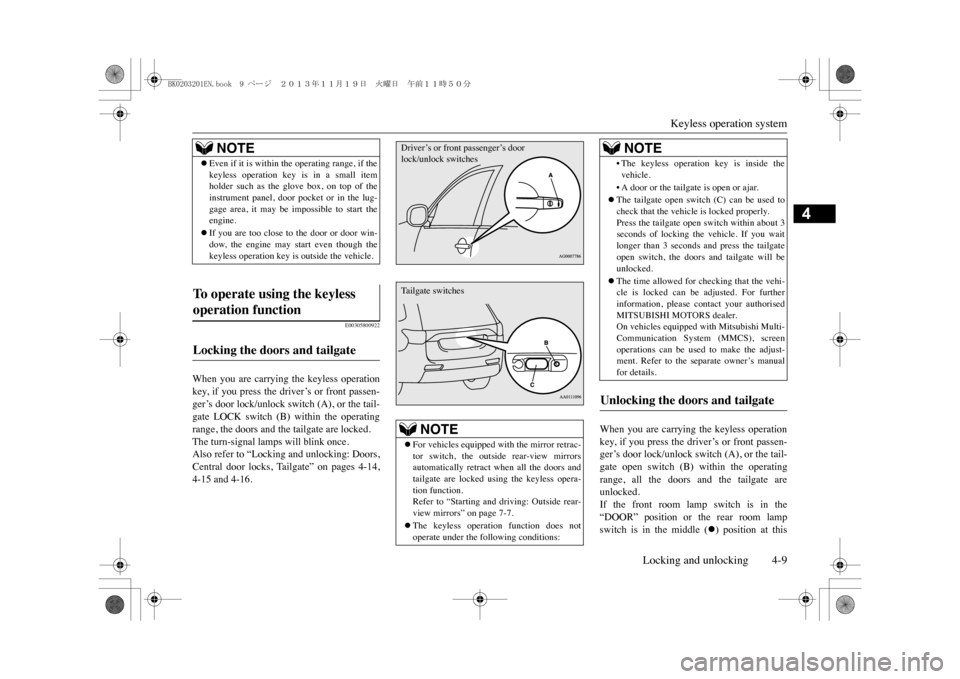
Keyless operation system
Locking and unlocking 4-9
4
E00305800922
When you are carrying the keyless operationkey, if you press the driver’s or front passen-ger’s door lock/unlock switch (A), or the tail-gate LOCK switch (B) within the operatingrange, the doors and the tailgate are locked.The turn-signal lamps will blink once.Also refer to “Locking and unlocking: Doors,Central door locks, Tailgate” on pages 4-14,4-15 and 4-16.
When you are carrying the keyless operationkey, if you press the driver’s or front passen-ger’s door lock/unlock switch (A), or the tail-gate open switch (B) within the operatingrange, all the doors and the tailgate areunlocked.If the front room lamp switch is in the“DOOR” position or the rear room lampswitch is in the middle (
�z) position at this
NOTE
�zEven if it is within the operating range, if thekeyless operati
on key is in a small item
holder such as the glove box, on top of theinstrument panel, door pocket or in the lug-gage area, it may be impossible to start theengine.�zIf you are too close to the door or door win-dow, the engine may start even though thekeyless operation
key is outside the vehicle.
To o p e r a t e u s i n g t h e k e y l e s s operation function Locking the doors and tailgate
NOTE
�zFor vehicles equipped wi
th the mirror retrac-
tor switch, the outside rear-view mirrorsautomatically retract when all the doors andtailgate are locked using the keyless opera-tion function.Refer to “Starting and driving: Outside rear-view mirrors” on page 7-7.�zThe keyless operati
on function does not
operate under the following conditions:
Driver’s or front passenger’s door lock/unlock switchesTa i l g a t e s w i t c h e s
•The keyless operation
key is inside the
vehicle.•A door or the tailgate is open or ajar.�zThe tailgate open switch (C) can be used tocheck that the vehicle is locked properly.Press the tailgate open switch within about 3seconds of locking the vehicle. If you waitlonger than 3 seconds
and press the tailgate
open switch, the doors and tailgate will beunlocked.�zThe time allowed for checking that the vehi-cle is locked can be adjusted. For furtherinformation, please contact your authorisedMITSUBISHI MOTORS dealer.On vehicles equipped
with Mitsubishi Multi-
Communication System (MMCS), screenoperations can be used to make the adjust-ment. Refer to the se
parate owner’s manual
for details.
Unlocking the doors and tailgate
NOTE
BK0203201EN.book 9 ページ 2013年11月19日 火曜日 午前11時50分
Page 89 of 388
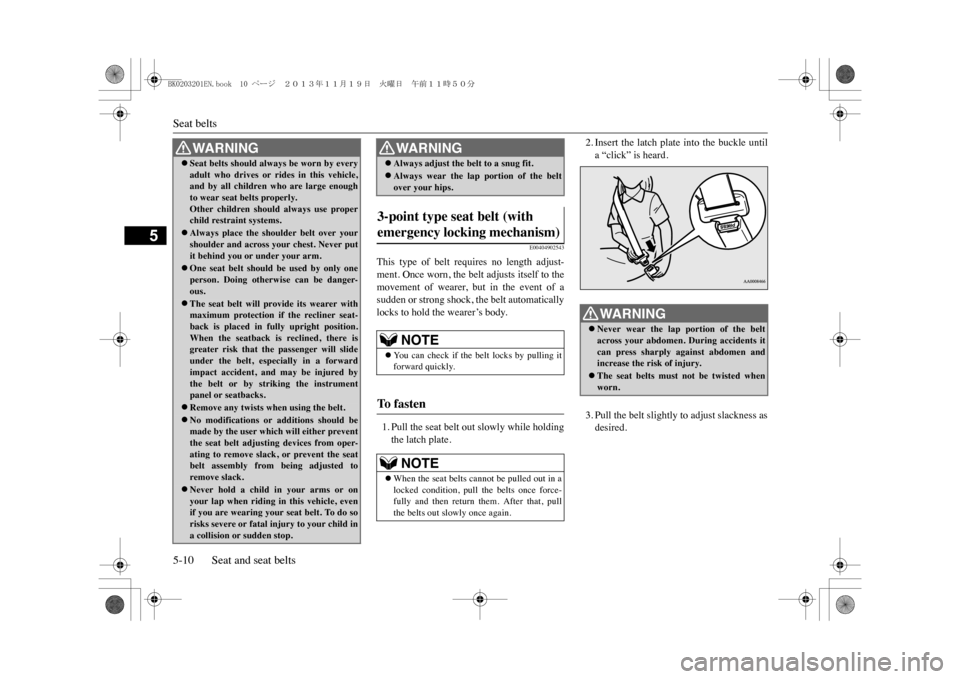
Seat belts5-10 Seat and seat belts
5
E00404902543
This type of belt requires no length adjust-ment. Once worn, the belt adjusts itself to themovement of wearer, but in the event of asudden or strong shock, the belt automaticallylocks to hold the wearer’s body.1. Pull the seat belt out slowly while holdingthe latch plate.
2. Insert the latch plate into the buckle untila “click” is heard. 3. Pull the belt slightly to adjust slackness asdesired.
WA R N I N G�zSeat belts should alw
ays be worn by every
adult who drives or rides in this vehicle,and by all children who are large enoughto wear seat belts properly.Other children should
always use proper
child restraint systems.�zAlways place the sh
oulder belt over your
shoulder and across your chest. Never putit behind you or under your arm.�zOne seat belt should
be used by only one
person. Doing otherwise can be danger-ous.�zThe seat belt will provide its wearer withmaximum protection if the recliner seat-back is placed in fully upright position.When the seatback is reclined, there isgreater risk that the passenger will slideunder the belt, especially in a forwardimpact accident, and may be injured bythe belt or by striking the instrumentpanel or seatbacks.�zRemove any twists when using the belt.�zNo modifications or
additions should be
made by the user which will either preventthe seat belt adjustin
g devices from oper-
ating to remove slack, or prevent the seatbelt assembly from being adjusted toremove slack.�zNever hold a child in your arms or onyour lap when riding in this vehicle, evenif you are wearing your seat belt. To do sorisks severe or fatal injury to your child ina collision or sudden stop.
�zAlways adjust the belt to a snug fit.�zAlways wear the lap portion of the beltover your hips.
3-point type seat belt (with emergency locking mechanism)
NOTE
�zYo u c a n c h e c k i f t h e b e l t l o c k s b y p u l l i n g i tforward quickly.
To f a s t e n
NOTE
�zWhen the seat belts cannot be pulled out in alocked condition, pull the belts once force-fully and then return them. After that, pullthe belts out slowly once again.WA R N I N G
WA R N I N G�zNever wear the lap portion of the beltacross your abdomen. During accidents itcan press sharply against abdomen andincrease the risk of injury. �zThe seat belts must not be twisted whenworn.
BK0203201EN.book 10 ページ 2013年11月19日 火曜日 午前11時50分
Page 101 of 388
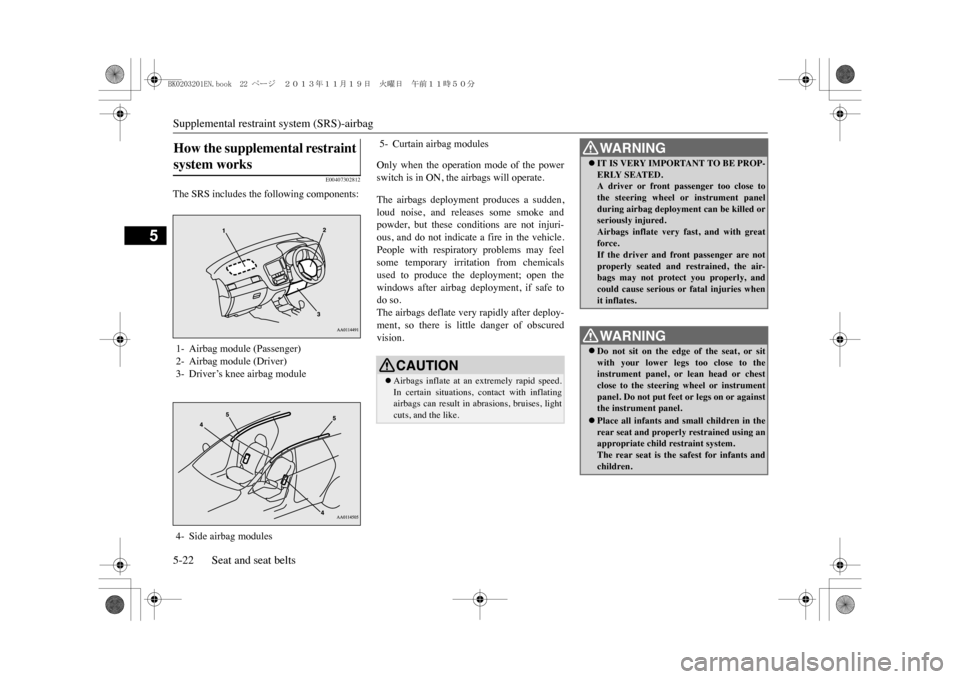
Supplemental restrain
t system (SRS)-airbag
5-22 Seat and seat belts
5
E00407302812
The SRS includes the following components:
Only when the operation mode of the powerswitch is in ON, the airbags will operate.The airbags deployment produces a sudden,loud noise, and releases some smoke andpowder, but these conditions are not injuri-ous, and do not indicate a fire in the vehicle.People with respiratory problems may feelsome temporary irritation from chemicalsused to produce the deployment; open thewindows after airbag deployment, if safe todo so.The airbags deflate very rapidly after deploy-ment, so there is little danger of obscuredvision.
How the supplemental restraint system works 1- Airbag module (Passenger)2- Airbag module (Driver)3- Driver’s knee airbag module4- Side airbag modules
5- Curtain airbag modules
CAUTION�zAirbags inflate at an extremely rapid speed.In certain situations, contact with inflatingairbags can result in abrasions, bruises, lightcuts, and the like.
WA R N I N G�zIT IS VERY IMPORTANT TO BE PROP-ERLY SEATED.A driver or front passenger too close tothe steering wheel or instrument panelduring airbag deployment can be killed orseriously injured.Airbags inflate very
fast, and with great
force.If the driver and front passenger are notproperly seated and restrained, the air-bags may not protect you properly, andcould cause serious or fatal injuries whenit inflates.WA R N I N G�zDo not sit on the edge
of the seat, or sit
with your lower legs too close to theinstrument panel, or lean head or chestclose to the steering wheel or instrumentpanel. Do not put feet or legs on or againstthe instrument panel.�zPlace all infants and small children in therear seat and properly restrained using anappropriate child restraint system.The rear seat is the safest for infants andchildren.
BK0203201EN.book 22 ページ 2013年11月19日 火曜日 午前11時50分
Page 102 of 388
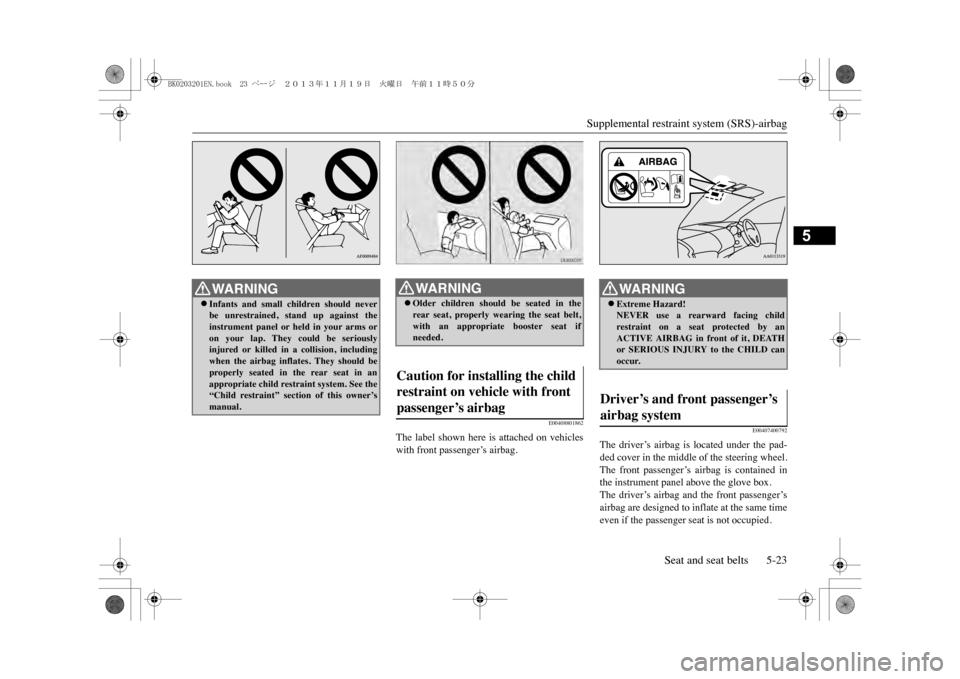
Supplemental restraint system (SRS)-airbag
Seat and seat belts 5-23
5
E00408801862
The label shown here is attached on vehicleswith front passenger’s airbag.
E00407400792
The driver’s airbag is located under the pad-ded cover in the middle of the steering wheel.The front passenger’s airbag is contained inthe instrument panel above the glove box.The driver’s airbag and the front passenger’sairbag are designed to inflate at the same timeeven if the passenger seat is not occupied.
WA R N I N G�zInfants and small children should neverbe unrestrained,
stand up against the
instrument panel or held in your arms oron your lap. They could be seriouslyinjured or killed in a collision, includingwhen the airbag inflat
es. They should be
properly seated in the rear seat in anappropriate child restraint system. See the“Child restraint” section of this owner’smanual.
WA R N I N G�zOlder children should be seated in therear seat, properly wearing the seat belt,with an appropriate booster seat ifneeded.
Caution for installing the child restraint on vehicle with front passenger’s airbag
WA R N I N G�zExtreme Hazard!NEVER use a rearward facing childrestraint on a seat protected by anACTIVE AIRBAG in front of it, DEATHor SERIOUS INJURY to the CHILD canoccur.
Driver’s and front passenger’s airbag system
BK0203201EN.book 23 ページ 2013年11月19日 火曜日 午前11時50分
Page 103 of 388
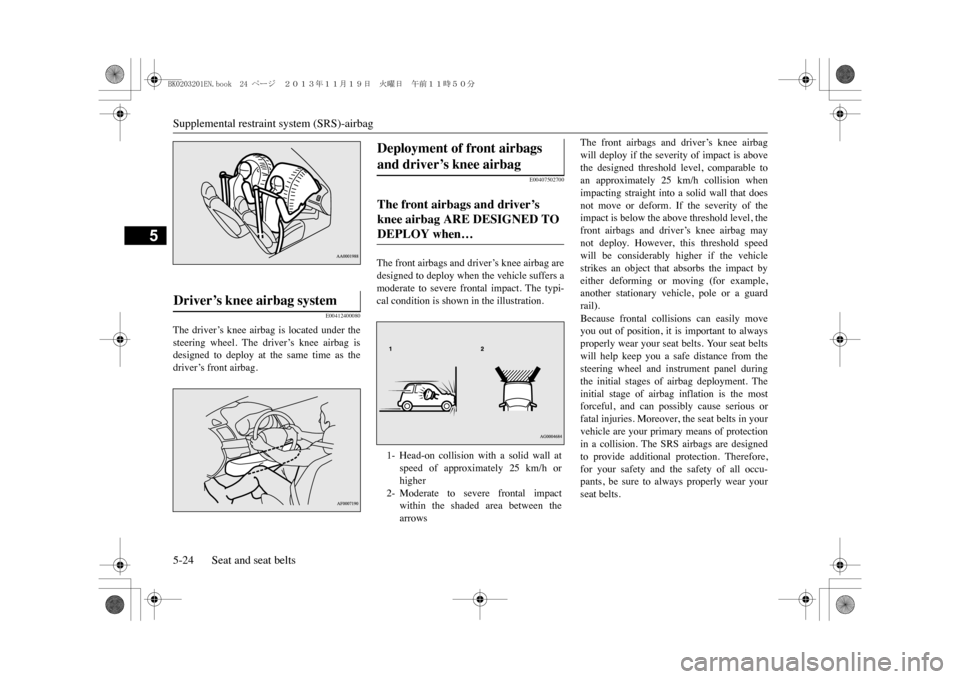
Supplemental restrain
t system (SRS)-airbag
5-24 Seat and seat belts
5
E00412400080
The driver’s knee airbag is located under thesteering wheel. The driver’s knee airbag isdesigned to deploy at the same time as thedriver’s front airbag.
E00407502700
The front airbags and driver’s knee airbag aredesigned to deploy when the vehicle suffers amoderate to severe frontal impact. The typi-cal condition is shown in the illustration.
The front airbags and driver’s knee airbagwill deploy if the severity of impact is abovethe designed threshold level, comparable toan approximately 25 km/h collision whenimpacting straight into a solid wall that doesnot move or deform. If the severity of theimpact is below the above threshold level, thefront airbags and driver’s knee airbag maynot deploy. However, this threshold speedwill be considerably higher if the vehiclestrikes an object that absorbs the impact byeither deforming or moving (for example,another stationary vehicle, pole or a guardrail).Because frontal collisions can easily moveyou out of position, it is important to alwaysproperly wear your seat belts. Your seat beltswill help keep you a safe distance from thesteering wheel and instrument panel duringthe initial stages of airbag deployment. Theinitial stage of airbag inflation is the mostforceful, and can possibly cause serious orfatal injuries. Moreover, the seat belts in yourvehicle are your primary means of protectionin a collision. The SRS airbags are designedto provide additional protection. Therefore,for your safety and the safety of all occu-pants, be sure to always properly wear yourseat belts.
Driver’s knee airbag system
Deployment of front airbags and driver’s knee airbag The front airbags and driver’s knee airbag ARE DESIGNED TO DEPLOY when… 1- Head-on collision with a solid wall at
speed of approximately 25 km/h orhigher
2- Moderate to severe frontal impact
within the shaded area between thearrows
BK0203201EN.book 24 ページ 2013年11月19日 火曜日 午前11時50分
Page 105 of 388
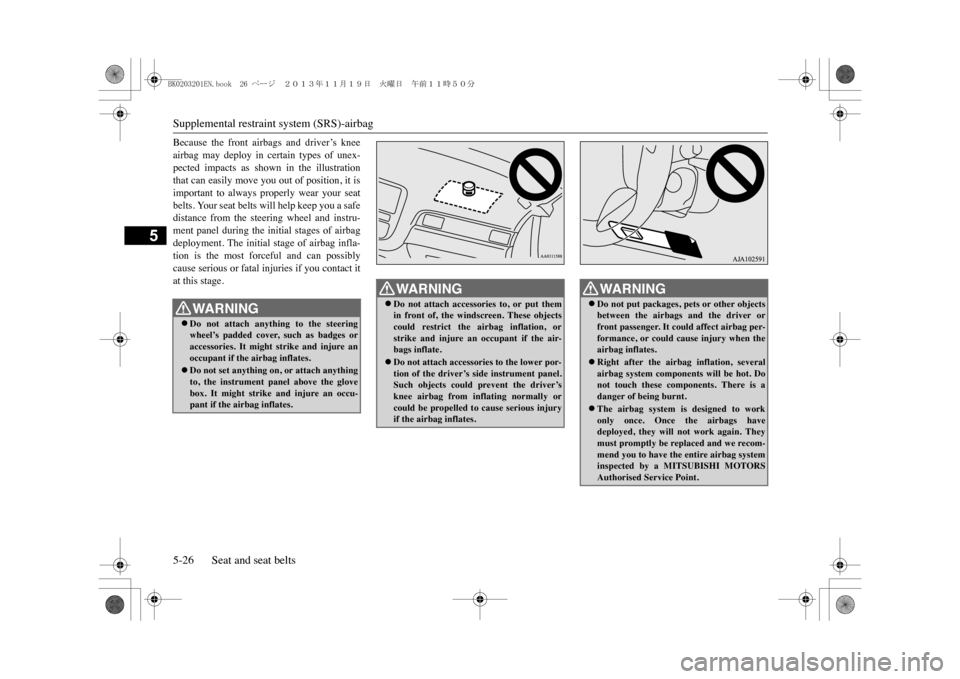
Supplemental restrain
t system (SRS)-airbag
5-26 Seat and seat belts
5
Because the front airbags and driver’s kneeairbag may deploy in certain types of unex-pected impacts as shown in the illustrationthat can easily move you out of position, it isimportant to always properly wear your seatbelts. Your seat belts will help keep you a safedistance from the steering wheel and instru-ment panel during the initial stages of airbagdeployment. The initial stage of airbag infla-tion is the most forceful and can possiblycause serious or fatal injuries if you contact itat this stage.
WA R N I N G�zDo not attach anything to the steeringwheel’s padded cover, such as badges oraccessories. It might strike and injure anoccupant if the airbag inflates.�zDo not set anything on, or attach anythingto, the instrument
panel above the glove
box. It might strike and injure an occu-pant if the airbag inflates.
WA R N I N G�zDo not attach accessories to, or put themin front of, the windscreen. These objectscould restrict the airbag inflation, orstrike and injure an occupant if the air-bags inflate.�zDo not attach accessories to the lower por-tion of the driver’s side instrument panel.Such objects could prevent the driver’sknee airbag from infl
ating normally or
could be propelled to cause serious injuryif the airb
ag inflates.
WA R N I N G�zDo not put packages, pets or other objectsbetween the airbags
and the driver or
front passenger. It could affect airbag per-formance, or could cause injury when theairbag inflates.�zRight after the airbag inflation, severalairbag system components will be hot. Donot touch these components. There is adanger of being burnt.�zThe airbag system is designed to workonly once. Once
the airbags have
deployed, they will not work again. Theymust promptly be replaced and we recom-mend you to have the entire airbag systeminspected by a MITSUBISHI MOTORSAuthorised Service Point.
BK0203201EN.book 26 ページ 2013年11月19日 火曜日 午前11時50分
Page 109 of 388
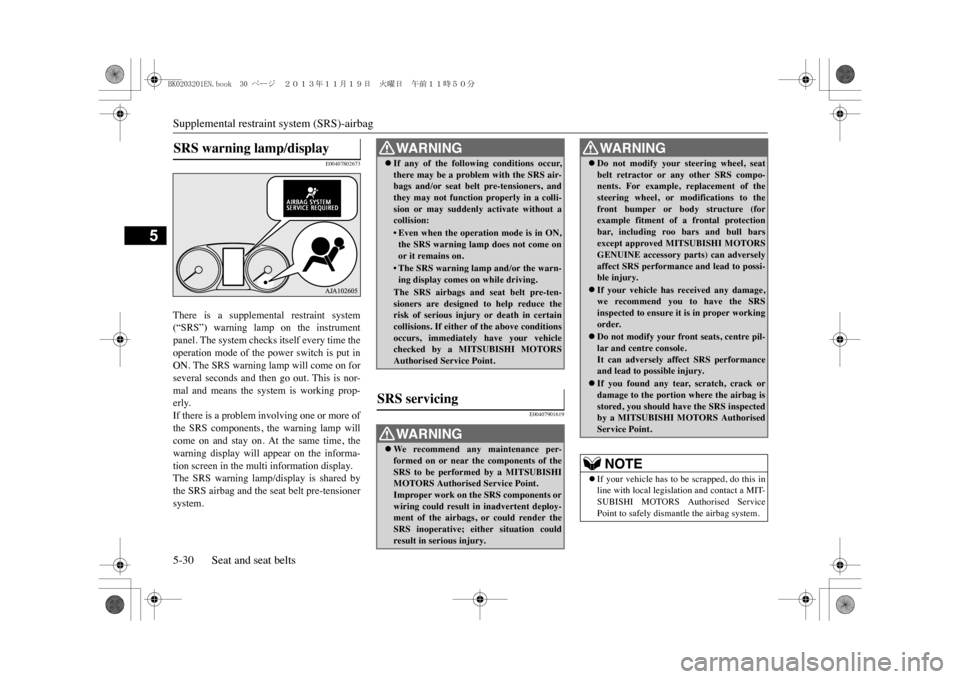
Supplemental restrain
t system (SRS)-airbag
5-30 Seat and seat belts
5
E00407802673
There is a supplemental restraint system(“SRS”) warning lamp on the instrumentpanel. The system checks itself every time theoperation mode of the power switch is put inON. The SRS warning lamp will come on forseveral seconds and then go out. This is nor-mal and means the system is working prop-erly.If there is a problem involving one or more ofthe SRS components, the warning lamp willcome on and stay on. At the same time, thewarning display will appear on the informa-tion screen in the mu
lti information display.
The SRS warning lamp/display is shared bythe SRS airbag and the seat belt pre-tensionersystem.
E00407901619
SRS warning lamp/display
WA R N I N G�zIf any of the following conditions occur,there may be a problem with the SRS air-bags and/or seat belt
pre-tensioners, and
they may not function
properly in a colli-
sion or may suddenly
activate without a
collision:•Even when the operation mode is in ON,the SRS warning lamp does not come onor it remains on.• The SRS warning lamp and/or the warn-ing display comes on while driving.The SRS airbags and seat belt pre-ten-sioners are designed to help reduce therisk of serious injury
or death in certain
collisions. If either of the above conditionsoccurs, immediately
have your vehicle
checked by a MITSUBISHI MOTORSAuthorised Service Point.
SRS servicing
WA R N I N G�zWe re commend any main tenanc e per-formed on or near the components of theSRS to be performed by a MITSUBISHIMOTORS Authorised Service Point.Improper work on the SRS components orwiring could result in inadvertent deploy-ment of the airbags,
or could render the
SRS inoperative; either situation couldresult in serious injury.
�zDo not modify your steering wheel, seatbelt retractor or any other SRS compo-nents. For example, replacement of thesteering wheel, or modifications to thefront bumper or body structure (forexample fitment of a frontal protectionbar, including roo bars and bull barsexcept approved MITSUBISHI MOTORSGENUINE accessory parts) can adverselyaffect SRS performance and lead to possi-ble injury.�zIf your vehicle has received any damage,we recommend you to have the SRSinspected to ensure it is in proper workingorder.�zDo not modify your front seats, centre pil-lar and centre console.It can adversely affect SRS performanceand lead to possible injury.�zIf you found any tear, scratch, crack ordamage to the portion where the airbag isstored, you should h
ave the SRS inspected
by a MITSUBISHI MOTORS AuthorisedService Point.NOTE
�zIf your vehicle has to be scrapped, do this inline with local legislation and contact a MIT-SUBISHI MOTORS Authorised ServicePoint to safely dismantle the airbag system.WA R N I N G
BK0203201EN.book 30 ページ 2013年11月19日 火曜日 午前11時50分
Page 127 of 388
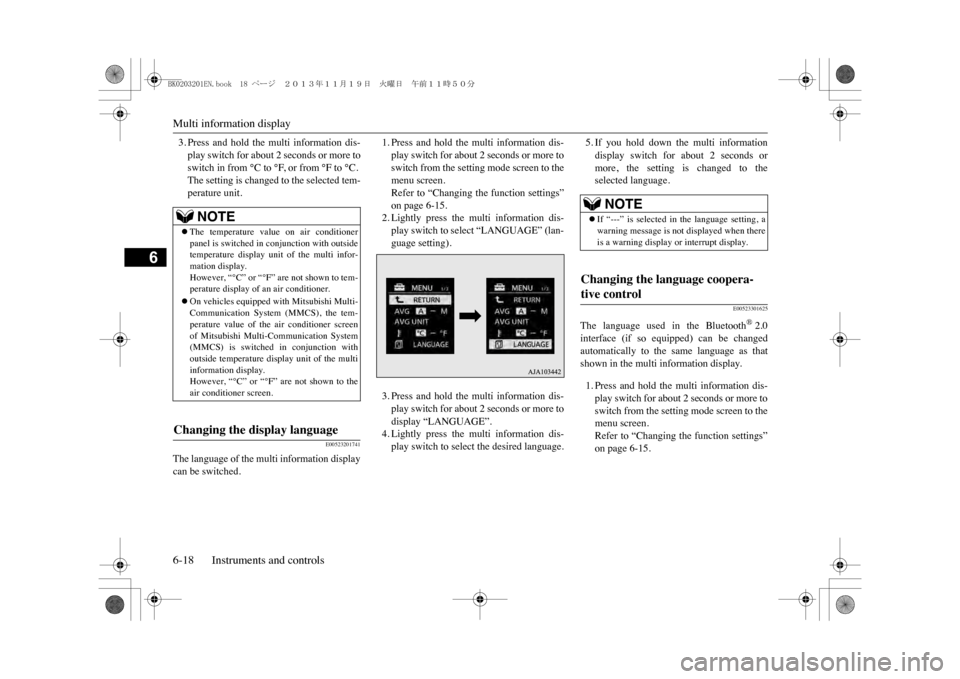
Multi information display6-18 Instruments and controls
6
3. Press and hold the multi information dis-play switch for about 2 seconds or more toswitch in from °C to °F, or from °F to °C.The setting is changed to the selected tem-perature unit.
E00523201741
The language of the multi information displaycan be switched.
1. Press and hold the multi information dis-play switch for about 2 seconds or more toswitch from the setting mode screen to themenu screen.Refer to “Changing the function settings”on page 6-15.2. Lightly press the multi information dis-play switch to select “LANGUAGE” (lan-guage setting).3. Press and hold the multi information dis-play switch for about 2 seconds or more todisplay “LANGUAGE”.4. Lightly press the multi information dis-play switch to select the desired language.
5. If you hold down the multi informationdisplay switch for about 2 seconds ormore, the setting is changed to theselected language.
E00523301625
The language used in the Bluetooth
®2.0
interface (if so equipped) can be changedautomatically to the same language as thatshown in the multi information display.1. Press and hold the multi information dis-play switch for about 2 seconds or more toswitch from the setting mode screen to themenu screen.Refer to “Changing the function settings”on page 6-15.
NOTE
�zThe temperature value on air conditionerpanel is switched in
conjunction with outside
temperature display unit of the multi infor-mation display.However, “°C” or “°F” are not shown to tem-perature display of an air conditioner.�zOn vehicles equipped
with Mitsubishi Multi-
Communication System (MMCS), the tem-perature value of the air conditioner screenof Mitsubishi Multi-Communication System(MMCS) is switched
in conjunction with
outside temperature display unit of the multiinformation display.However, “°C” or “°F” are not shown to theair conditioner screen.
Changing the display language
NOTE
�zIf “---” is selected in the language setting, awarning message is not
displayed when there
is a warning display or interrupt display.
Changing the language coopera-tive control
BK0203201EN.book 18 ページ 2013年11月19日 火曜日 午前11時50分